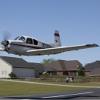Have had vacuum pumps fail at about 500, all VMC. Generator partially failed at some point. Engine failure. Have had only partial on various airplanes. Significant because it scared me and forced me to land, but not catastrophic like forcing me to ditch.
I deal a lot with the statistics of aircraft systems failure in my regular job. The FAA has surprisingly low criteria for engine failure, because the failure alone is not considered to be at the catastrophic level. They figure that the plane can still glide and stalls at a theoretically survivable landing speed, plus crash survivability. The primary flight data has higher integrity demands than the engine. Even there, it is backups that matter. Vacuum pumps will fail, but hopefully not at the same time the electrical system. Even electronic flight displays assume a backup, because of the statistical failure rate. Best bet is always dissimilar solutions. Vacuum AND electronic display are actually quite complementary, although I’ve not run the numbers.

